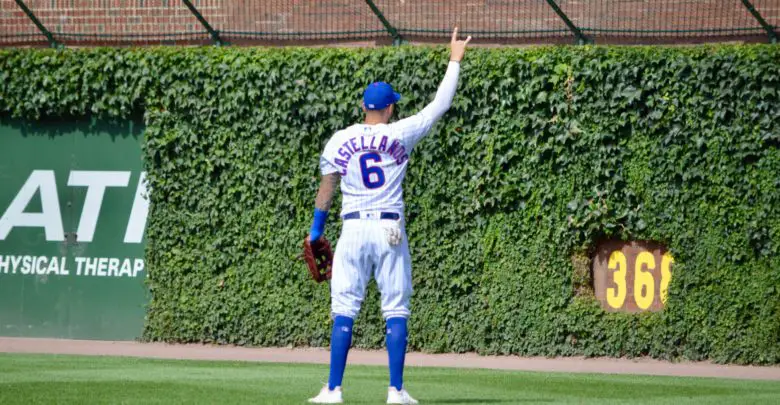
Let’s Spend a Few Moments on Idea That Cubs Could Sign Nicholas Castellanos Sans Trades
The Cubs’ offseason to this point has been nothing short of a funeral procession, with an ominous bass drum beat sounding for each free agent they don’t sign while the staccato rattle of the snare punctuates each report that they won’t spend money. There’s no brass section to liven things up, no woodwinds to provide haunting interludes between solemn thuds and dry taps. Nor is there a parade route or even a program to let onlookers know where the hell this thing is headed.
Oh, we think we know what’s going on since the direction has been made pretty clear by all the moves that haven’t been made. After all, it’s unlikely that the end result of this boring-ass march to March is a flurry of big trades and signings that suddenly launch the Cubs to the top the power rankings. But what if they are playing coy to an extent? What if, after years of avoiding the gimmick of a big player announcement at Cubs Convention, ownership wants to make a splash again.
Mind you, I don’t believe that is the case and I find it far more plausible that the goal for this winter is to reset their tax penalties by getting under the $208 million competitive balance tax threshold. More than just the nominal — and make no mistake, eating $10 million or so in penalties is a minor cost when it comes to landing the right players — luxury tax they’d be levied for maintaining a payroll similar to last year’s, the Cubs are up against much heftier losses should they become repeat CBT offenders.
Rather than just paying more money out in a penalty, the Cubs could miss out on significant revenue-sharing reimbursements that could reach as high as $50 million if things break the right way. We can certainly debate the merits of choosing to limit payroll as a means by which to recoup that money, particularly when Cubs ownership has said that owning a professional sports team is not in and of itself a money-making endeavor, but the strategy appears to be taking shape.
Unless it’s all been a ruse and the plan the whole time has been to finalize a deal with Comcast to carry Marquee Sports Network, after which the business operations side will open the checkbook to make payroll additions. More specifically, the Cubs would have the money to re-sign Nicholas Castellanos without first gutting the team he wanted to return to. That is admittedly far-fetched and more than a little conspiratorial, though it does connect a few of the dots still lingering out there based on multiple reports and heavy speculation.
Let’s start with Castellanos, who appears to be willing to wait on the Cubs for at least a little while longer before making a decision on his next team. Reports of mutual interest have been there since the start of free agency and they continue even as the Cubs appear to be unable to afford the likes of Eric Sogard and Shogo Akiyama. Jon Morosi told MLB Network last week that the Cubs “are one team that still has some interest in bringing him back” and Jim Bowden lists them first in terms of fit (subscription required, though the money you spend on one can’t be skimmed like international signing bonuses) for Castellanos in his predictions for The Athletic.
It’s been assumed and reported all along that the Cubs would have to swing a trade or three to free up enough money for Castellanos, since his $15-20 million AAV means going way over the CBT mark again. The trouble with that is changing the face of the team and making the Cubs a less attractive option. Unless, of course, he believes in the front office’s vision and thinks that at least being competitive in three of the four years he figures to get on a deal make up for losing other core players.
That would fit under the idea that Castellanos already has an agreement in principle with the Cubs and is simply waiting for them to be in the right position to make an offer. I want to be clear here once again that I don’t believe such an agreement exists, though I don’t doubt for a second the notion that the outfielder is willing to circle back to Theo Epstein for a final chance to match other offers he receives from the Rangers or whomever.
Having confidence in their ability to bring Castellanos back might allow the Cubs a little more leeway to maintain the presumption of austerity in the meantime. While it’s most likely that they’re not making trades because the market hasn’t fully formed as a result of the pending decision on Kris Bryant’s grievance and the fact that Josh Donaldson remains unsigned, it’s possible the real money the Cubs are looking to free up lies elsewhere. As in the guarantee of broad carriage of Marquee across their MLB-defined broadcast territory.
They’ve already got about 40% of their carriage deals done, having already agreed with AT&T’s family of carriers, plus Mediacom and Charter Communications, but Comcast is the biggie. As the dominant player in Chicagoland, the cable giant would go a long way toward ensuring the most possible coverage and highest possible revenues. Remember, Marquee didn’t bring the same kind of immediate windfall that most teams receive from inking new TV deals. Since the Cubs are partners with Sinclair Broadcasting, they had to foot a lot of the start-up costs and need both broad carriage and the subsequent advertising revenue from it in order to max out their profits.
Paying luxury tax penalties while missing out on tens of millions more in rebates and rev-sharing dollars would be bad enough on its own, but doing so with a new network that only half of your fans can watch would be a massive PR nightmare. As such, the Cubs wouldn’t do anything to meaningfully increase payroll until the ink is dry on a Comcast deal that ensures Marquee launches in February on as many televisions as possible.
If they land that big fish prior to Cubs Convention, they can fly Castellanos out to Chicago and make him the marquee announcement just before they make the Marquee announcement. Boom, there it is.
More than likely, however, is that the Cubs solidify their carriage arrangements and still try to get under the CBT threshold for 2019. That could still involve signing Castellanos, just with the same caveat that it requires them to free up space first. Maybe that means they can really go for broke ahead of the 2021 season with their penalties reset and a new CBA coming the following season. If you want to hold onto that hope as a means by which to justify this winter, you’re more than welcome to do so.
Anyway, thanks for following along with this little thought exercise of mine. If nothing else, I think it serves to show how the same situation can be viewed differently based on your perspective. Mine hasn’t really changed since the season ended, which is to say I believe it’s a mistake for the Cubs to not spend big on payroll when they’ve got a brand-new TV network launching. Even with a better understanding of the costs involved, I’m not a fan of pulling back on the reins in the hope that next year will provide the opportunity to make a big splash. If they even plan on going big at all.
You may feel otherwise, especially if you’re among the legions of fans who fell in love with Castellanos as the result of his breakout performance since coming to the Cubs in a last-second deadline trade. Or perhaps you feel the team needs to spend on pitching, in which case you’re already well aware of how they’ve missed the boat on that front this winter.
I guess I’ll conclude by saying that it’s impossible to completely rule out any option until the door to it has been slammed shut. Which reminds me of a great dad joke: When is a door not a door? When it’s ajar.
Ed. note: A lot of people have been asking about Marquee’s availability on Dish Network, so I figured I’d bury this way at the end where no one will read it. Dish has eliminated several RSNs already and has been vocal about how those channels are financial drags. As such, it isn’t likely that Marquee will get a deal, especially when the games are blacked out for subscribers beyond the Cubs’ regional territory.
As for those who are talking about either choosing or refusing to pay the extra $4-6 per month to have Marquee, you’re not going to have much of a choice. While it’s possible some negotiations result in Marquee’s placement on a premium tier, the plan is to have it as part of the basic package in order to rake in as much revenue as possible. So if you want to stand on principle and not pay for it, you’re going to have to make sure you’re with a TV provider that doesn’t carry it.

